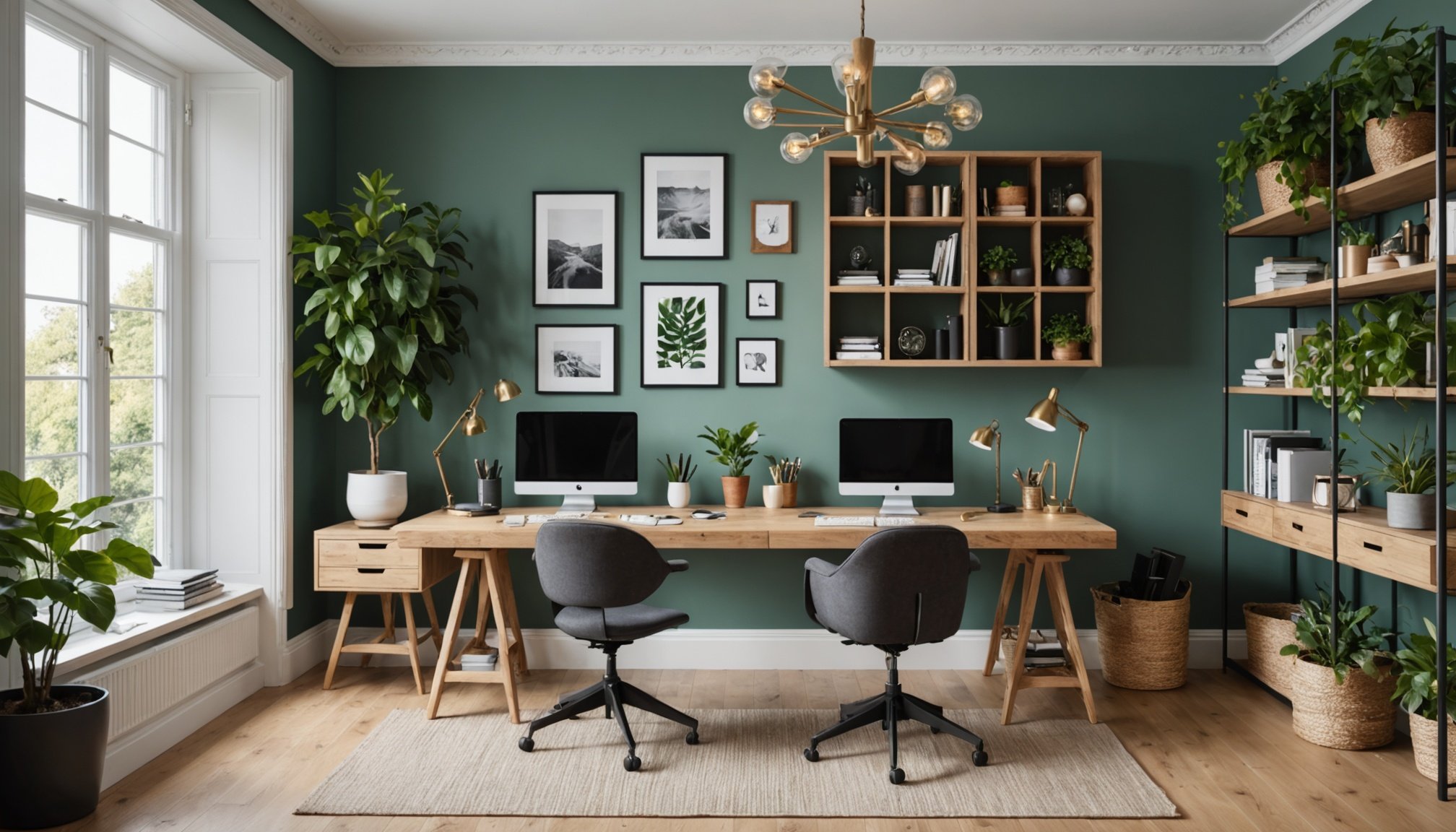Transforming your UK home office with biophilic design can enhance both your productivity and well-being. By integrating natural elements, such as plants, organic materials, and ample light, you create an inspiring workspace that fosters creativity. Imagine working surrounded by greenery and sunlight; this approach links your indoor environment to nature, reducing stress. Discover innovative strategies to elevate your home office, merging functionality with a refreshing aesthetic. Embrace the beauty of biophilia and inspire a workspace where you thrive.
Understanding Biophilic Design
Biophilic design is an innovative approach that integrates nature into the built environment, enhancing human well-being. At its core, this design philosophy aims to reconnect people with the natural world by incorporating elements such as natural light, vegetation, and water features into architectural spaces. The definition of biophilic design revolves around creating environments that mimic natural ecosystems, fostering a sense of tranquility and balance.
Dans le meme genre : What are the best ways to display collectibles in a UK home without clutter?
The benefits of biophilic design are profound. Research indicates that exposure to natural elements can significantly improve mental health, reduce stress, and increase overall happiness. These positive effects on well-being are crucial, especially in urban settings where access to nature is limited. By integrating nature into our daily environments, biophilic design supports a healthier lifestyle.
Moreover, biophilic design has been linked to enhanced productivity. Studies show that workplaces incorporating natural elements see increased employee engagement and efficiency. The presence of natural light and greenery can boost concentration and creativity, leading to better performance and job satisfaction. This connection between biophilic design and productivity highlights its potential to transform workspaces into more inspiring and effective environments.
Avez-vous vu cela : Transform Your Contemporary UK Living Room: Seamlessly Incorporating a Victorian Era Fireplace
Benefits of Biophilic Design in Home Offices
Incorporating biophilic design into home offices can significantly enhance both mental health and productivity. Natural elements, such as light and greenery, play a pivotal role in creating a calming environment. Exposure to these elements has been shown to reduce stress and anxiety, promoting better mental health. This is particularly beneficial in home offices, where work-life balance can be challenging to maintain.
Furthermore, biophilic design can substantially boost productivity. Studies indicate that workplaces featuring natural elements experience heightened employee engagement and efficiency. In a home office setting, the presence of natural light and plants can improve concentration and creativity, leading to enhanced performance and job satisfaction.
Several case studies illustrate the transformative power of biophilic design in home offices. For instance, a study revealed that participants working in environments with abundant natural light reported higher levels of alertness and focus. Another case highlighted the positive impact of indoor plants on reducing mental fatigue and increasing cognitive function.
By integrating biophilic elements into home office spaces, individuals can create a more inspiring and effective work environment that supports both mental health and productivity.
Incorporating Plants in Your Home Office
Integrating indoor plants into your home office can significantly enhance both the aesthetics and air quality of the space. Plants not only add a natural touch to your environment but also purify the air, creating a healthier workspace. Selecting the right plants and arranging them creatively can transform your office into a more inviting and productive area.
Choosing the Right Plants
When choosing indoor plants, consider factors such as light availability, space, and maintenance requirements. Low-maintenance plants like snake plants or pothos are ideal for beginners. These plants are resilient and thrive in various lighting conditions, making them perfect for home offices.
Maintenance Tips for Office Plants
Proper care is crucial for maintaining indoor plants. Regularly check soil moisture and adjust watering schedules accordingly. Ensure your plants receive adequate light, and consider rotating them to promote even growth. Dust leaves occasionally to keep them clean and healthy.
Creative Plant Arrangements
Get creative with plant arrangements to enhance both aesthetics and functionality. Consider hanging planters to save desk space or grouping plants of different heights for visual interest. By thoughtfully arranging your indoor plants, you can create a dynamic and stimulating work environment that supports well-being and productivity.
Utilizing Natural Materials
Incorporating natural materials into a home office can create a warm and inviting atmosphere that promotes well-being and productivity. These materials, such as wood and stone, offer both aesthetic appeal and functional benefits.
Types of Natural Materials Suitable for Home Offices
Integrating materials like wood, stone, and bamboo can enhance the look and feel of your workspace. Wood accents, such as desks or shelves, add warmth and texture, creating a cozy environment. Stone elements, like a desktop or decorative pieces, bring an earthy touch that can ground the space.
Benefits of Using Wood and Stone Elements
Wood accents are not only visually appealing but also durable and versatile. They can seamlessly blend with various design styles, from modern to rustic. Stone elements, on the other hand, are known for their strength and timeless beauty. They can serve as focal points or subtle enhancements, adding a natural elegance to your office.
Incorporating Sustainable Materials in Design
Choosing eco-friendly design options is essential for a sustainable home office. Opt for sustainably sourced wood and recycled materials to minimise environmental impact. Bamboo, a rapidly renewable resource, is an excellent choice for furniture and accessories. By prioritising sustainable materials, you contribute to a healthier planet while creating a beautiful workspace.
Optimizing Natural Light
Enhancing natural light in your workspace can significantly boost efficiency and well-being. Natural light not only improves mood but also reduces eye strain and increases alertness. To maximize daylight in your office, consider strategic lighting design techniques.
Position your desk near windows to take full advantage of the available sunlight. This arrangement ensures that you receive ample natural light throughout the day, promoting a more energizing work environment. Additionally, using mirrors can reflect light deeper into the room, further enhancing brightness without artificial sources.
Window treatments play a crucial role in optimizing natural light. Opt for sheer curtains or blinds that allow light to filter through while reducing glare. These treatments can maintain privacy and regulate the amount of sunlight entering the space, creating a balanced and comfortable atmosphere.
Consider incorporating light-coloured walls and surfaces in your workspace optimization plan. Lighter shades reflect light more effectively, making the area feel more open and airy. By thoughtfully designing your office to harness natural light, you can create a space that supports both productivity and well-being, making your work environment more pleasant and efficient.
Colour Schemes Inspired by Nature
Incorporating colour psychology into your home office design can significantly impact mood and productivity. Colours inspired by nature, such as greens, blues, and earthy tones, are known to create a calming and balanced atmosphere. Understanding how different colours influence emotions can help you craft a workspace that enhances focus and creativity.
Nature-Inspired Colour Palettes for Home Offices
Nature-inspired colours are becoming a popular design trend for home offices. These palettes often feature hues found in natural settings, such as forest greens, ocean blues, and sandy beiges. These tones not only bring the tranquillity of the outdoors inside but also foster a sense of connection to the natural world.
Examples of Effective Colour Application in Design
- Green: Often associated with growth and renewal, green can boost concentration and reduce stress. Consider painting an accent wall in a soft green or adding green accessories.
- Blue: Known for its calming effects, blue can enhance focus and mental clarity. Use blue in your office chair or wall art.
- Earthy Tones: Browns and beiges provide warmth and stability. Incorporate these through wooden furniture or decor items.
By thoughtfully selecting nature-inspired colours, you can create a harmonious and productive work environment.
Practical Tips for Implementing Biophilic Design
Integrating biophilic design into your home office can be both rewarding and straightforward. By following a few practical steps, you can create a workspace that enhances well-being and productivity.
Step-by-Step Guide to Creating a Biophilic Workspace
-
Assess Your Space: Identify areas where natural elements can be incorporated. Consider lighting, available surfaces, and existing decor.
-
Select Natural Elements: Choose elements such as indoor plants, natural materials, and nature-inspired colours. These will form the foundation of your biophilic design.
-
Arrange Thoughtfully: Position plants near windows for optimal light. Use natural materials like wood for furniture, and incorporate nature-inspired colours on walls or accessories.
Affordable DIY Projects to Enhance Your Office
-
DIY Plant Holders: Create custom plant holders using recycled materials. This adds a personal touch and promotes sustainability.
-
Nature-Inspired Wall Art: Craft artwork using natural materials like leaves or stones. This can bring a unique aesthetic to your workspace.
Resources for Sourcing Biophilic Design Elements
- Local nurseries and garden centres often provide a variety of plants suitable for indoor environments.
- Online marketplaces offer eco-friendly materials and nature-inspired decor, allowing you to shop sustainably.











